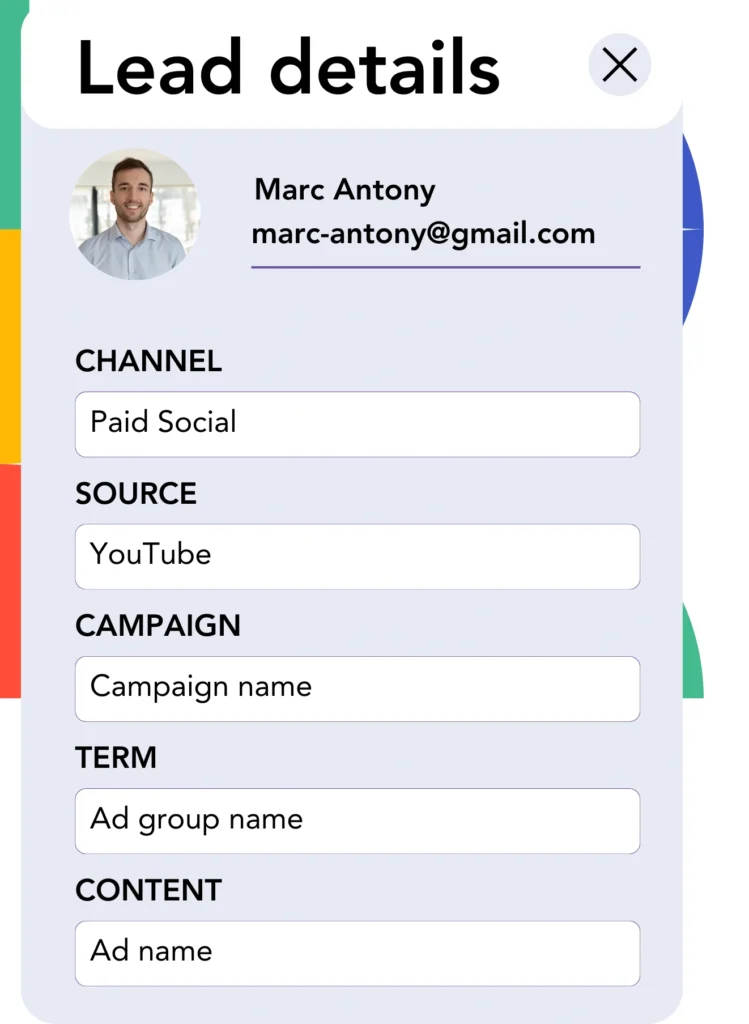Leads generated on YouTube are imported into NetSuite CRM, but tracking each lead’s originating YouTube ad is not an option. Even when leads turn into customers, associating them with their YouTube source is impossible.
This lack of tracking data prevents you from measuring YouTube ads success, making it difficult to identifying which ads generate leads and customers. As a result, you spend without clarity on each ad’s performance.
Luckily, there’s an accessible way to trace each lead back to the exact YouTube campaign, ad group, and ad that brought it in.
We’ll get through this step by step!
How to Track YouTube Ads in NetSuite CRM
Step 1: Add Leadsources in the head tag of your website

Leadsources makes tracking lead origins simple. After adding it to your site, it captures up to 7 key data points for each lead.
➡️ Sign up to Leadsources.io for free
➡️ Add the Leadsources tracking code to your site
Step 2: Add the UTM parameters to your YouTube Ads

In your ad URL, insert UTM parameters to capture data from YouTube ads, such as campaign, ad group, and ad. Here’s a good example:
UTM_source=YouTubeUTM_campaign=campaign-nameUTM_term=ad-group-nameUTM_content=ad-name
This is the format your final URL will take:
https://www.yourdomain.com/?&UTM_source=youtube&UTM_campaign=campaign-name&UTM_term=ad-group-name&UTM_content=ad-nameImportant: Leadsources ensures every lead’s source is captured, even without the use of UTM parameters.
Step 3: Add the hidden fields in your form

In a form, hidden fields are used to store data that is not visible to the user but is submitted with the form.
Leadsources captures lead source data in hidden fields. When the lead submits the form, these fields are automatically filled with YouTube Ads information.
Step 4: Capture the YouTube Ads data in NetSuite CRM

Leadsources fetches the YouTube campaign, ad group, and ad data when users click on your ads and arrive on your site.
Leadsources takes the YouTube ad data and inserts it into the hidden fields of your form.
After submitting the form, the YouTube ad data and lead details will appear in NetSuite CRM (ensure the form is connected to NetSuite CRM).
How does Leadsources work?
Whenever a user lands on your site, Leadsources fetches YouTube ad data and populates it into the hidden fields on your form. Once the form is submitted, this data and the lead’s information are sent to NetSuite CRM.
Each lead in Leadsources is associated with detailed source data:
| Lead source data | Fetched automatically |
| Channel | ✅ |
| Source | ✅ |
| Campaign | ✅ OR use UTM_campaign |
| Content | UTM_content parameter is required |
| Term | UTM_term parameter is required |
| Landing page | ✅ |
| Landing page subfolder | ✅ |
As detailed in the table above, when UTM parameters aren’t applicable—like for organic sources such as Google search or when your website is mentioned in an article—Leadsources still tracks the following lead source data:
- Channel
- Source
- Campaign
- Landing page
- Landing page subfolder
Unlike other platforms, Leadsources tracks lead sources efficiently across both paid and organic channels.
Performance reports: Lead, sales, and revenue by source
Tracking YouTube Ads data in NetSuite CRM lets you produce performance reports such as:
- Leads, sales, and revenue by channel
- Leads, sales, and revenue by source
- Leads, sales, and revenue by campaign (aka. YouTube campaign)
- Leads, sales, and revenue by term (aka. YouTube ad group)
- Leads, sales, and revenue by content (aka. YouTube ad)
This data allows you to manage your YouTube Ads budget more effectively by concentrating on the campaigns, ad groups, and ads that drive the best results in leads, sales, and revenue.
Let’s go over the reports you can generate to track your results!
1. Lead source reports
Create reports to analyze the number of leads sourced by:
- Channel
- Source
- Campaign (aka. YouTube campaign)
- Term (aka. YouTube ad group)
- Content (aka. YouTube ad)
- Landing page
- Landing page subfolder
Example #1: Leads by channel
This report gives you an overview of which channel drives the highest lead volume.

Example #2: Leads by YouTube campaign
Now, you can focus on a lead source (e.g., YouTube) and observe the performance of each YouTube campaign in terms of lead generation.

Example #3: Leads by YouTube ad
Once you figure out which YouTube campaign has the most leads, you can analyze the ad group or ad that’s making that possible.

2. Sales and revenue source reports
Now that we know which YouTube campaign, ad group, and ad bring in leads, we need to assess whether those leads are converting into sales and revenue.
By connecting your leads to a CRM such as NetSuite CRM, you’ll be able to track sales and revenue across channels, sources, YouTube campaigns, ad groups, ads, landing pages, and subfolders.
This data allows you to shift your YouTube Ads strategy toward the channels, sources, campaigns, ad groups, and ads that bring the highest sales and revenue.
You can generate different reports for tracking sales and revenue, such as:
- Sales and revenue by channel
- Sales and revenue by source
- Sales and revenue by campaign
- Sales and revenue by term (e.g., YouTube ad group)
- Sales and revenue by content (e.g., YouTube ad)
- Sales and revenue by landing page
- Sales and revenue by landing page subfolder
Example Scenario:
| Channel | Search Paid | Social Paid |
|---|---|---|
| Leads | 50 | 75 |
| Sales | 5 | 6 |
| Average Order Value | $150 | $100 |
| Revenue | $750 | $600 |
Following the launch of ads on Google and YouTube, the first “Leads by Channel” report revealed that Social Paid ads on YouTube generated more leads than Search Paid ads on Google.
Upon examining the sales and revenue data in NetSuite CRM, you found that the Search Paid channel was bringing in more revenue with fewer leads compared to the Social Paid channel. This led you to shift your budget towards the Search Paid channel.
LeadSources tracks the source of each lead in NetSuite CRM, whether they come from ads, organic search, social, email, etc. and syncs that data with each submission. See the full breakdown on the lead source in NetSuite CRM page.

